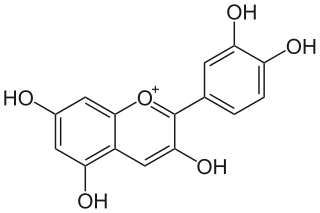This page is based on this
Wikipedia article Text is available under the
CC BY-SA 4.0 license; additional terms may apply.
Images, videos and audio are available under their respective licenses.

Anthocyanidins are common plant pigments. They are the sugar-free counterparts of anthocyanins based on the flavylium ion or 2-phenylchromenylium, which is a type of oxonium ion. They form a large group of polymethine dye. In particular anthocyanidins are salt derivatives of the 2-phenylchromenylium cation, also known as flavylium cation. As shown in the figure below, the phenyl group at the 2-position can carry different substituents. The counterion of the flavylium cation is mostly chloride. With this positive charge, the anthocyanidins differ from other flavonoids.
31 monomeric anthocyanidins have been properly identified, most of the anthocyanins are based on cyanidin (30%), delphinidin (22%), and pelargonidin (18%), respectively. Altogether 20% of the anthocyanins are based on the three common anthocyanidins that are methylated. Around 3, 3, and 2% of the anthocyanins or anthocyanidins are labeled as 3-desoxyanthocyanidins, rare methylatedanthocyanidins, and 6-hydroxyanthocyanidins, respectively.

In astronomy, Bok globules are isolated and relatively small dark nebulae, containing dense cosmic dust and gas from which star formation may take place. Bok globules are found within H II regions, and typically have a mass of about 2 to 50 solar masses contained within a region about a light year or so across (about 4.5×1047 m3). They contain molecular hydrogen (H2), carbon oxides and helium, and around 1% (by mass) silicate dust. Bok globules most commonly result in the formation of double- or multiple-star systems.

Delphinidin is an anthocyanidin, a primary plant pigment, and also an antioxidant. Delphinidin gives blue hues to flowers in the genera Viola and Delphinium. It also gives the blue-red color of the grape that produces Cabernet Sauvignon, and can be found in cranberries and Concord grapes as well as pomegranates, and bilberries.

Cyanidin is a natural organic compound. It is a particular type of anthocyanidin. It is a pigment found in many red berries including grapes, bilberry, blackberry, blueberry, cherry, cranberry, elderberry, hawthorn, loganberry, açai berry and raspberry. It can also be found in other fruits such as apples and plums, and in red cabbage and red onion. It has a characteristic reddish-purple color, though this can change with pH; solutions of the compound are red at pH < 3, violet at pH 7-8, and blue at pH > 11. In certain fruits, the highest concentrations of cyanidin are found in the seeds and skin. In a recent study, cyanidin was found to be a potent sirtuin 6 (SIRT6) activator.

Peonidin is an O-methylated anthocyanidin derived from Cyanidin, and a primary plant pigment. Peonidin gives purplish-red hues to flowers such as the peony, from which it takes its name, and roses. It is also present in some blue flowers, such as the morning glory.
In enzymology, a leucocyanidin oxygenase (EC 1.14.11.19) is an enzyme that catalyzes the chemical reaction
In enzymology, an anthocyanin 5-aromatic acyltransferase is an enzyme that catalyzes the chemical reaction
In enzymology, an anthocyanin 6"-O-malonyltransferase is an enzyme that catalyzes the chemical reaction
In enzymology, an anthocyanidin 3-O-glucosyltransferase is an enzyme that catalyzes the chemical reaction

Anthocyanins are water-soluble vacuolar pigments that, depending on their pH, may appear red, purple, or blue. Food plants rich in anthocyanins include the blueberry, raspberry, black rice, and black soybean, among many others that are red, blue, purple, or black. Some of the colors of autumn leaves are derived from anthocyanins.
The molecular formula C16H13O7 (or C16H13O7+, molar mass : 317.27 g/mol, exact mass : 317.066127317) or C16H13ClO7 (exact mass : 352.03498) may refer to :
The chemical formula C15H11O6 (C15H11O6+, molar mass : 287.24 g/mol, exact mass : 287.0555626) may refer to :
The molecular formula C15H11O5 (or C15H11O5+, molar mass : 271.24 g/mol, exact mass 271.060648) may refer to :
The chemical formula C17H15O7 (or C17H15O7+, molar mass : 331.2968 g/mol, exact mass :331.081778) may refer to :
The molecular formula C15H11O7 (molar mass : 303.24 g/mol, exact mass : 303.050477) may refer to:
The molecular formula C18H17O7 (or C18H17O7+, molar mass : 345.32 g/mol, exact mass : 345.097428) may refer to :

Hirsutidin is an O-methylated anthocyanidin, a chemical compound belonging to the anthocyanins. It can be found in Catharanthus roseus where it is the prominent compound in petals and can also be found in callus cultures.

Leucoanthocyanidin (flavan-3,4-diols) are colorless chemical compounds related to anthocyanidins and anthocyanins. Leucoanthocyanins can be found in Anadenanthera peregrina and in several species of Nepenthes including N. burbidgeae, N. muluensis, N. rajah, N. tentaculata, and N. × alisaputrana.

Leucocyanidin is a colorless chemical compound that is a member of the class of natural products known as leucoanthocyanidins.

Pulchellidin (Pl) is an O-methylated anthocyanidin. It is a blue-red plant pigment. It can be found in Plumbago pulchella.











